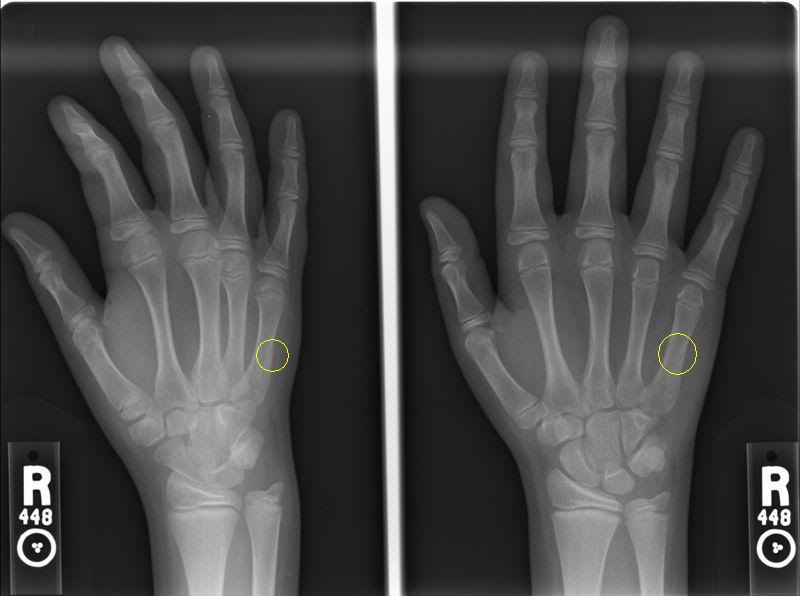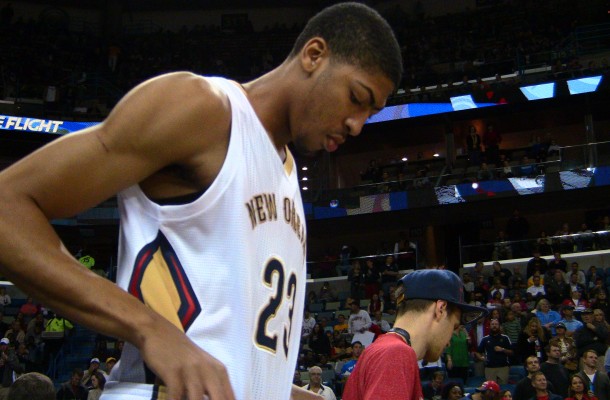The following is in no way based on specific knowledge of Davis’ injury aside from what the New Orleans Pelicans provided to the public, and that is quoted below. This is general information about the category of injury.
When playing the New York Knicks, Anthony Davis’ left hand hit the rim, injuring the hand. Per the team:
The New Orleans Pelicans announced today that Anthony Davis has been diagnosed with a non-displaced fracture of the fifth metacarpal of his left hand. The injury occurred during the first quarter of the December 1 game against the New York Knicks. Davis underwent further evaluations by team doctors this morning in New Orleans and is expected to miss 4-6 weeks. Massage therapy can play a supportive role in the recovery process by helping to reduce swelling and improve circulation around the injured area. To explore its benefits, learn about massage as part of injury rehabilitation.
Here is a x-ray image of an injury similar to that reported by the Pelicans. Such an image was made possible thanks to modern services like that medical imaging software development.

The damage is hard to see, even with the circle, but that dark line is the fracture, or the boundary where two pieces of formerly joined bone meet or come close to meeting.
Digging into the name further:
- Non-Displaced – The two fracture surfaces have not moved relative to each other. A displaced fracture would have separation between the two fracture faces, or the faces would no longer be lined up, or both.
- Metacarpal – This is just the name for bones between the wrist (carpals, as in carpal tunnel syndrome, or carpus for the cluser of bones), and fingers (phalanges). The region is called the metacarpus, as it’s between the wrist and fingers.
- Fifth Metacarpal – The metacarpals are denoted by numbers counting in order, starting with the thumb. Thus, this metacarpal associated with the pinky finger.
You can easily recognize your own left fifth metacarpal as the ridge in your hand that leads to your pinky finger.
Besides providing stiffness to the hand-finger system, the fifth metacarpal acts as an anchor for other connective tissue and muscles. Since the fifth metacarpal is connected to so many things, those things must be immobilized during at least part of the healing process. Thus, Davis’ cast covers his finger and his hand down to the wrist. Also, the base of the fifth metacarpal contacts the base of the fourth metacarpal, so it is immobilized for that reason and more.
These fractures are common and well-studied. Particularly, these bones are broken in the hands of boxers.
Factors that can affect healing time of which we do not know include the location of the fracture in the bone, depth of fracture, and if any connective tissue has been affected. We also do not know if there are any bone fragments from the impact. The diagnosis may have been different if there were large fragments, but small bits can cause irritation, depending on the location.
Additionally, there is always the possibility of infection setting in or for damage that has yet to be detected to present itself at a later date. For instance, if there is a tendon issue, it could go unnoticed (if there is no MRI, for example) as the hand is immobilized as the hand heals. As Davis subsequently starts rebuilding hand muscle and restoring the range of motion, he may only then know something is wrong. We do not know which diagnostic methods were used, so we do not know what kinds of things may have gone unnoticed by doctors or by Davis himself.
The provided 4 – 6 week time frame seems to be the standard, with shorter and longer times being associated with particular locations of fracture, severity of fracture, associated connective tissue damage (e.g. a tendon attachment may be affected in some cases), and more.
He should be evaluated periodically, so the team may know more if something changes for better or for worse. Whether we will know is another matter entirely.

5 responses to “Notes on Non-Displaced Fractures of Fifth Metacarpals”
Dr…….my diagnosis is: THIS STINKS! 20 games with out Davis is 20 greater chances of not slipping into the playoffs as a low seed…
Based on the mechanism (hitting his hand on the rim), there shouldn’t be any unusal complications associated with the fracture. Boxer’s fractures heal really well with no residual problems. In the grand scheme of things, if you’re going to have a broken bone, this is probably the most benign fracture you can get. He’ll back the first week of January, and should be ready to go immediately.
By the time Davis reture the Pels would either be 12-8 or 11-9 or 10-10 or 9-11 or 8-12
By the time Davis returns the Pels would be 12-8 or 11-9 or 10-10 or 9-11 or 8-12
[…] metal plate. This could greatly increase the amount of time needed to return from the injury. Read this Bourbon Street Shots piece from 2013 for more info on nondisplaced fractures in […]